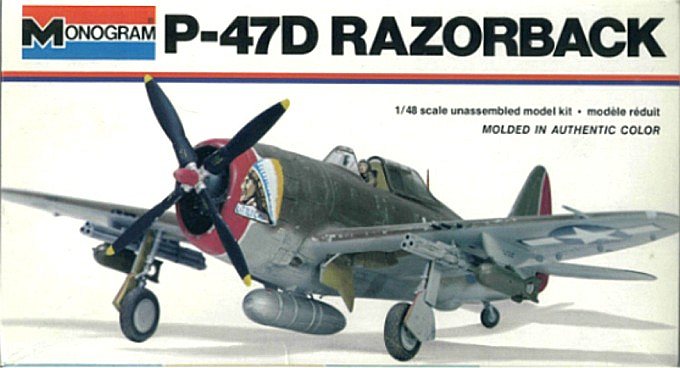
|
KIT: |
Monogram 1/48 P-47D Razorback |
|
KIT # |
5302 |
|
PRICE: |
$2.25 (1977) |
|
DECALS: |
Two Aircraft |
|
REVIEW : |
|
|
NOTES: |
` |

|
HISTORY |
"It vill be a dinosaur, but a dinosaur vit goot proportions"--Alexander Kartveli. So began the odyssey of the P-47 Thunderbolt, the United States Army’s most prolific pursuit plane of WWII. Sharing its design between Alexander Kartveli and Alexander De Seversky, the "Jug", as it affectionately became known among its flight- and ground-crews, almost never occurred. After producing a series of radial-engined pursuit ships offering, paradoxically, innovative features and lackluster performance, Republic Aircraft Corporation (the scion of Seversky’s original Long Island-based company) designed a new aircraft around Allison’s ubiquitous liquid-cooled V-1710, which by this time was powering most of the Army Air Corps’ fighter planes.
On paper the proposal looked good, but as early combat reports from Europe during the first year of the war were assessed, it became apparent that the V-12 Allison-powered aircraft (designated the XP-47) would not be competitive with then-extant designs already in service with the Axis powers, or even those of the Allies. Air Corps-mandated equipment additions and changes eventually forced Kartveli back to the drawing board before the XP-47 ever reached the hardware stage. Allegedly sketching a preliminary plan on the back of an envelop, he laid out a new design using many conventional features from the company’s earlier P-35 and P-41/43 projects.
The large aircraft assumed almost cumbersome proportions with its barrel-shaped fuselage and broad-chord elliptical wing. Pratt & Whitney’s R-2800 ‘Twin Wasp’, fitted with General Electric’s new exhaust-driven turbosupercharger and harnessed to a Curtiss Electric prop measuring 12 feet, 2 inches in diameter, was chosen to power the airplane, promising 400+ MPH and a service ceiling in excess of 35,000 ft. Four Browning .50 caliber machineguns would be mounted in each wing, impressive and unprecedented for a fighter plane. Entrance to the cockpit was to be accomplished by means of a quasi-car door arrangement, later found to render emergency egress a risky proposition under any circumstance.
The new aircraft gestated from proposal to prototype in nine months with the initial roll-out of the newly-designated XP-47B occurring on 6 May 1941. Army Air Corps officials, duly impressed, immediately ordered an accelerated flight test program to ready the ship for production. Teething problems immediately surfaced, mainly due to the plane’s extraordinary performance and capabilities. High altitude operation produced severe arcing in the engine’s ignition system, requiring a pressurized ignition harness, while terminal velocity dives caused the doped fabric-covered rudder and elevators to disintegrate. All-metal control surfaces cured that, while minor modifications rectified some oiling problems with the turbosupercharger.
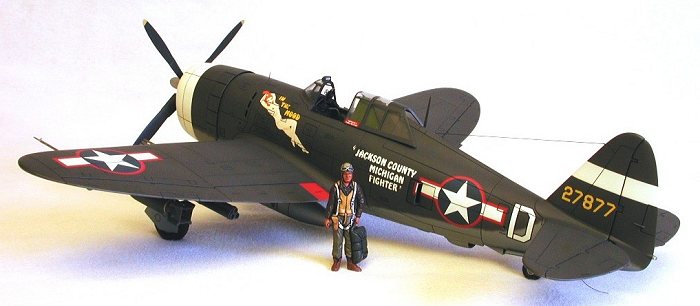
Army officials stipulated a more conventional canopy arrangement so Republic engineers re-designed the layout under a standard sliding hood. The cockpit floorboard was raised significantly to allow for less restricted forward visibility, while a waste-gate regulator was installed on the turbosupercharger to prevent over-revving. Finally, the doped-fabric ailerons were discarded in favor of aluminum-skinned surfaces as a result of continuing problems encountered during dives exceeding 500kts IAS.
Thusly configured, the newly-christened P-47B Thunderbolt was placed into production with the first aircraft assigned to the 56th FG on Long Island, New York and arriving in June of 1942. The 56th was the only P-47 combat unit to train stateside, becoming de facto the cadre from which most ETO-bound units would draw personnel from. Training attrition losses were horrendously high, as is typical of cutting edge aviation technology, and over half of the group’s initial issue of aircraft were destroyed in accidents.
The first Thunderbolt to deploy overseas was the P-47C which differed from the B model with the addition of an eight-inch fuselage extension forward of the firewall, providing better access to the engine accessory drive section and a more favorable center-of-gravity. Minor detail differences to the oxygen, electrical, and hydraulic systems along with revised oil cooler shutters completed the metamorphosis from the earlier model. Three 8th AF fighter groups were initially equipped with the P-47C: the 4th, 56th, and 78th. Operations commenced in mid-March of 1943, with the first bomber escort sorties flown on the 17th of August on the Schweinfurt mission.
The next production model was the P-47D, and initially, the designation was a result of a newly-constructed plant at Evansville, Indiana and a need for AAF bean-counters to differentiate between the Farmingdale facility on Long Island for accounting purposes. Substantial upgrades eventually forced the New York plant to adopt the D designation as well. These enhancements included additional cowl flaps and improved armor protection for the cockpit. To keep Army bookkeepers and comptrollers happy, the New York airplanes carried the suffix of ‘RE’ while those made in Indiana were marked as ‘RA’.
Early on, the D model was fitted with wing pylons plumbed for jettisonable drop tanks as well as increased internal fuel capacity and payload. Water injection was fitted to the R-2800 to minimize pre-detonation at altitude, while the exhaust system was improved and simplified. Late in the production run, the Farmingdale, NY plant began installing the Hamilton Standard 13’-1 7/8" Hydramatic propeller in place of the Curtiss Electric unit.
Constant carping by flight crews regarding the limited rearward visibility produced an innovative solution at the Farmingdale facility. An early D was pulled from production and modified by cutting away the upper-aft fuselage and covering the area with new circular-shaped sheet metal. A blown Perspex bubble canopy, borrowed from a Hawker Tempest and shipped from England was fitted on a sliding track mounted to the rear of the pilot’s armored headrest, while a new flat-paned armored windscreen was installed forward.
Initially designated the XP-47K, it was eventually standardized and placed into production as the P-47D-25-RE. Fitted with the Hamilton Standard prop, internal differences from the "razorback" model included additional oxygen and internal fuel capacity, a new gun sight, and improved fuel system controls. The Evansville plant produced a similar model designated the P-47D-26-RA equipped with the Curtiss Electric prop.
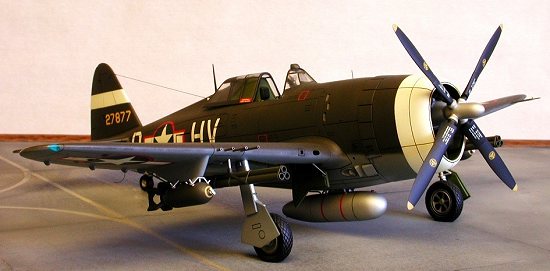 A pair of flush-mount anti-compressibility dive brakes were fitted to the
P-47D-30 to give pilots more controllability during rapid descent, located
between the gear wells and the flaps. By this time both plants had standardized
on the Curtiss Electric paddle blade prop, rendering both the D-30-RE and
D-30-RA visually identical. The D-40-RA was the final P-47D model and introduced
a small dorsal fin fillet to eliminate tail flutter, tail warning radar, the
K-14 gun sight, and provisions for HVAR launch stubs to replace the earlier
bazooka tube mounts.
A pair of flush-mount anti-compressibility dive brakes were fitted to the
P-47D-30 to give pilots more controllability during rapid descent, located
between the gear wells and the flaps. By this time both plants had standardized
on the Curtiss Electric paddle blade prop, rendering both the D-30-RE and
D-30-RA visually identical. The D-40-RA was the final P-47D model and introduced
a small dorsal fin fillet to eliminate tail flutter, tail warning radar, the
K-14 gun sight, and provisions for HVAR launch stubs to replace the earlier
bazooka tube mounts.
Thunderbolts acquitted themselves quite well in all theaters to which they were deployed, with many an ace claiming them as their mounts. The ruggedly-constructed airframes could, and did, absorb a brutally punishing amount of battle damage and remain aloft, while the brawny P & W R-2800 engine could sustain flight even with several cylinders shot away. Many pilots owed their lives to the large amount of armor plate in the cockpit. A sizeable number were provided to Allied air forces under Lend-Lease provisions.
Performing bomber escort, fighter sweep, and ground support missions, P-47s bore the lion’s share of these duties until the arrival of the Merlin-powered Mustangs in January of 1944. Even then, the Thunderbolt was considered superior for low-level sorties as it did not slavishly rely on Prestone and a radiator for engine cooling, always a liability with the P-51. Production ended in October of 1945 with 15,677 P-47s of all marks produced.
In the post-war era of the dawning jet age, many Air National Guard units were equipped with various marques of the Thunderbolt, where they continued to serve as late as the mid-50s. Their military service continued south of the border in Central and South America where as late as 1964, front-line examples could still be found in fighting trim. Many of these aircraft were re-imported to the United States where private citizens purchased and restored them as Warbirds.
|
THE KIT |
Monogram’s P-47D Razorback kit contains forty-six olive green parts and a clear two-piece canopy with separately-molded armored glass pane. The instruction pamphlet offers a brief history of the aircraft, a recommended assembly sequence, and painting suggestions with generic color call-outs. Decals for two aircraft are included: 42-25836, coded ‘HV M’ with "Pengie III" noseart, in bare metal overall, and; 42-76179, coded ‘HV V’ and wearing "Little Chief" artwork, in the OD/NG color scheme. Both machines were assigned to the 56th Fighter Group, 8th Air Force.
The parts breakdown is conventional with upper and lower wing halves, the fuselage split vertically, with one-piece stabilizers and a separately attached cowling. The surface detail consists of delicately-molded raised panel lines and access panels with recessed reveals around the control surfaces and cowl flaps. This kit shares many components from Monogram’s earlier ‘bubbletop’ Thunderbolt release, specifically the wings, empennage, landing gear, cockpit, engine, and cowling.
The cockpit is an oversimplified four-piece affair that, while usable to some, is better replaced by aftermarket resin or scratch-building. A two-piece seated pilot figure is included, but like the cockpit, he’s not one of Monogram’s better efforts, being original-issue from the 1967 bubbletop kit as well. The landing gear is adequate to the task, featuring treaded tires, covered wheel hubs, and separate actuators for the inner doors. The wells are properly detailed as are the inside door surfaces.
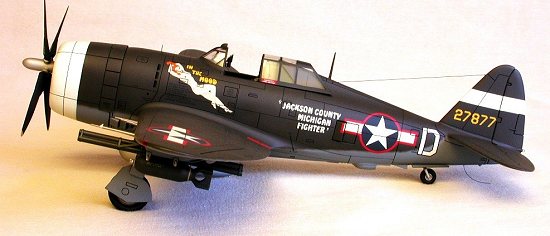 The clear parts are exceptional, with the framing correctly depicted and the
separate parts allowing for an open canopy option. Careful pre-fitting will be
necessary to get the armored glass correctly positioned behind the windscreen.
To economize on tooling costs, the guns, pitot tube, and antenna mast are molded
integral with the wing and fuselage parts, making seam clean-up that much more
of an irritant.
The clear parts are exceptional, with the framing correctly depicted and the
separate parts allowing for an open canopy option. Careful pre-fitting will be
necessary to get the armored glass correctly positioned behind the windscreen.
To economize on tooling costs, the guns, pitot tube, and antenna mast are molded
integral with the wing and fuselage parts, making seam clean-up that much more
of an irritant.
External stores consist of a 108-gallon resin-impregnated paper drop tank for the centerline, a 500-lb GP demolition bomb for each wing pylon, and a pair of four-piece bazooka tube rocket launchers to mount inboard of the pylons. Molding dimples on the rocket tubes will ensure hours of filling and sanding, doubtlessly enjoyable for masochists and shut-ins.
The engine and cowling are holdovers from the bubbletop kit, while the propeller is a new casting intended to represent the Curtiss Electric 12’-2" unit. However, the hub and spinner are underscale, imparting a toy-like appearance to the part. The one-piece P & W powerplant, undoubtedly a state-of-the-art molding in 1967, would benefit by additional detailing and/or replacement.
The decals, while colorful and on-register, appear thick and overly glossy. A modest amount of service stenciling is included, along with properly-sized national insignia in sufficient numbers. However, Monogram decals are notoriously difficult to apply and aftermarket alternatives should be seriously considered.
|
CONSTRUCTION |
The first order of bidness (a little Southwestern lingo) was to construct and install a proper cockpit, so after removing and detailing the seat from the kit’s one-piece cockpit tub I scratch-built a new seat frame, floorboard, and side consoles, anchored to new front and rear bulkheads. Photo-etched brass True Details seatbelts were used, along with various bits of Plastruct sheet, Evergreen rod, wound guitar string, and stretched sprue to detail the assembly.
Prior to installing the cockpit I drilled out the accessory drive cooling louvers on the fuselage halves and removed the exhaust shutters, replacing them with bits of K & S rectangular brass channel. Molded cooling vents at the rear of the turbo-supercharger shroud were replaced with photo-etched stainless steel grills. I installed a baffle inside each intercooler outlet to prevent ‘see-through’, then attached the new cockpit and glued the fuselage together.
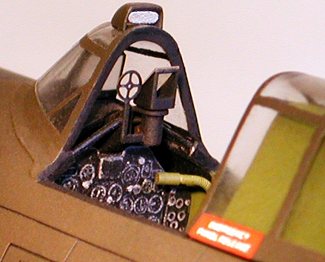 After cleaning up the seams I scratch-built a new gun sight and mount,
including the stand-by ring and bead, and installed it under the instrument
panel coaming. The armored glass required some modification, and after getting
it properly positioned I attached the windscreen with Testors liquid cement. A
pre-shaped piece of clear sprue was cemented into a notch carved into the rudder
to serve as a rear position light.
After cleaning up the seams I scratch-built a new gun sight and mount,
including the stand-by ring and bead, and installed it under the instrument
panel coaming. The armored glass required some modification, and after getting
it properly positioned I attached the windscreen with Testors liquid cement. A
pre-shaped piece of clear sprue was cemented into a notch carved into the rudder
to serve as a rear position light.
With the fuselage roughed in, I sanded and rescribed the stabilizers then attached them, using a piece of brass wire as a spar to strengthen the joints and maintain the correct dihedral angle (in this case, zero degrees). After smoothing the fillets out I sanded and rescribed the rest of the fuselage, then moved forward to the engine and cowling.
I opened up the intake cooling ducts below the engine then attached some fine-mesh screen at the rear of the diffuser vanes, both to add some detail and to prevent ‘see-through’. I installed a long piece of 1/8" aluminum tubing at the front of the engine to serve as a bearing for the propeller shaft. I purposely made it long on the inside to allow it to slip into a hole drilled into the fuselage firewall, providing additional mounting support to the engine/cowling assembly.
After examining the kit prop at length, I decided that in addition to the spinner and hub being underscale, the cuffs were incorrectly shaped as well. A little recon through the spares box produced a Curtiss Electric unit from Monogram’s Marauder, which looked much more the part, especially after lopping off 1/16" from the end of each blade and reshaping the tip. I installed a 3/32" aluminum tubing shaft at the rear and set it aside for the final assembly.
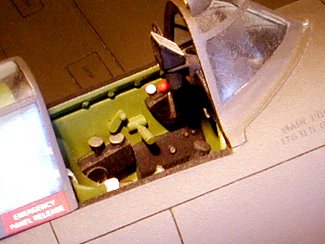 To backdate the aircraft to P-47D-1 standards, I spliced sheet styrene bits
to the lower cowl flaps and squared them flush with the rear of the existing
flaps, then sanded them smooth. After carving new separation lines between the
flaps for a little more definition and thinning the trailing edges, the engine
and cowling were attached to the fuselage then I turned my attention to the
wings.
To backdate the aircraft to P-47D-1 standards, I spliced sheet styrene bits
to the lower cowl flaps and squared them flush with the rear of the existing
flaps, then sanded them smooth. After carving new separation lines between the
flaps for a little more definition and thinning the trailing edges, the engine
and cowling were attached to the fuselage then I turned my attention to the
wings.
I opened up the shell ejection chutes and after gluing the halves together I cut off the guns and pitot tube, then sanded the seams to achieve a proper airfoil shape. Red and blue-green Lexan was installed at the wingtips, replicating the position lights. Sockets constructed from 1/16" aluminum tubing were added to the leading edge of the wings, to serve as receptacles for new guns and a pitot tube, scratch-built from #20 hypodermic needles.
At the starboard wing root, square brass channel was fashioned into a gun camera aperture while 1/8" tubing, crushed to an oval cross section, was used as a cockpit fresh air intake. The red, green, and amber combat ID lights outboard of the wing pylon were drilled out to accept MV lenses after painting and decaling, while on the underside of the port wing the landing light was similarly addressed, using a large white lens.
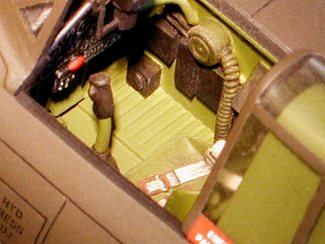 With the wings complete, I sanded them smooth, rescribed the surface detail,
then cemented them to the fuselage with gap-filling Hot Stuff. Careful
pre-fitting eliminated a few fit problems but gaps appeared nonetheless.
Repeated filling and sanding were necessary to get the wing fillets properly
blended and shaped.
With the wings complete, I sanded them smooth, rescribed the surface detail,
then cemented them to the fuselage with gap-filling Hot Stuff. Careful
pre-fitting eliminated a few fit problems but gaps appeared nonetheless.
Repeated filling and sanding were necessary to get the wing fillets properly
blended and shaped.
I moved to the landing gear next, replacing most of each strut with aluminum tubing and steel wire. After installing the struts, new inner door actuators were constructed from hypodermic needles with chrome-plated straight pins used for the pistons. A set of True Details resin wheels with uncovered hubs were attached after carefully fitting them to the axles at the correct negative camber angle.
With a ‘flyable’ airframe in hand, I logged a few test hops around the studio, including an impromptu strafing sortie against Punkus, my beloved Brown Burmese cat, snoozing sedately in a spare chair. Undaunted, he valiantly maintained his Morphean condition. Close observation led me to conclude that the model looked like a Jug indeed, so I proceeded to address the final construction details.
The 108-gallon paper drop tank was modified to resemble the metal equivalent and fitted to the fuselage with brass mounting pins, then detailed with scratch-built sway braces and wire ‘plumbing’. The bombs were likewise hung on the wing pylons with .013" guitar string used for the rear stabilizer and sheet aluminum cut into strips to represent the sway braces.
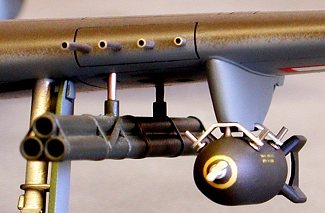 After weighing the prospects for assembling, correcting, and detailing the
kit-supplied bazooka tubes I decided I could scratch-build a better set in less
time. 3/32" tubing was used, with .003" brass shim stock strips used to tie the
tubes into a single unit and as bracing struts. Bits from a paper clip were
fashioned into mounts, and after a couple of test-fittings the stores were
removed and set aside, to be painted and decaled later.
After weighing the prospects for assembling, correcting, and detailing the
kit-supplied bazooka tubes I decided I could scratch-build a better set in less
time. 3/32" tubing was used, with .003" brass shim stock strips used to tie the
tubes into a single unit and as bracing struts. Bits from a paper clip were
fashioned into mounts, and after a couple of test-fittings the stores were
removed and set aside, to be painted and decaled later.
Final detailing included an ILS localizer whip antenna under the port wing made from a piece of .010" guitar string and friction-fit into a pre-drilled hole. For the external rearview mirror, I carved a master mold from a solid chunk of Lucite and vacuformed the fairing, using my Mattel machine and an original piece of the supplied .010 plastic. After drilling a small hole in the top of the windscreen I mounted a photo-etched True Details mirror and white-glued the fairing over it.
The HF dorsal antenna wire was done in a method similar to that used on my P-51D.
After anchoring 2 lb-test monofilament to the fin I inserted the other end into a scratch-built insulated lead-in on the fuselage. To pull the line taut, I made a hook out of a long piece of .010" guitar string. After inserting the hook into the hole for the yet-to-be-installed tail wheel well, I fished around until I snagged the line and pulled it through the opening. With the monofilament held taut from the inside with a Kelly clamp, I glued the line solidly inside the fuselage near the fin and cut off the excess.
After installing the tail wheel and door assembly I built a mast antenna from .010" sheet brass and glued it to the spine. Underneath, I built a ground strap (again using monofilament line) and attached it forward of the rudder. A panic bar was added to the canopy, and after checking and adjusting the canopy’s fit to the rails I gave the model a final inspection and rolled it into the paint shop.
|
PAINT & MARKINGS |
This was one of the few models I’ve ever built ‘on spec’…that is, I wasn’t sure what markings would eventually be used when I started the kit. The only criteria certain was that it would be camouflaged in the standard ANA 41/43 paint scheme and wear the red surround national insignia typical of the mid-1943 timeframe.
As the gear struts were already aluminum-colored, I painted the wells and inner door surfaces with zinc chromate then masked the areas and sprayed a home-brewed mix of neutral gray on the ventral surfaces. Topside, I used a darkened olive drab after masking the windscreen, canopy, and exterior lights.
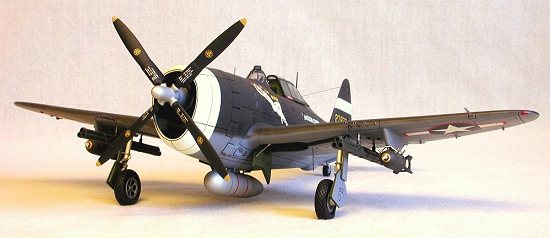 During the painting phase of this project a TDY trip took me to Ft. Bliss. A
Saturday sojourn to a local hobby shop put me in contact with several
newly-released Superscale sheets including 48-533, covering P-47Cs and early Ds.
It featured decals for P-47D-1-RE 42-7877, Major Jerry Johnson’s ‘In The Mood’,
assigned to the 63rd FS, 56th FG, 8th AF. A
sucker for Vargas girl nose art, flush went my per diem money.
During the painting phase of this project a TDY trip took me to Ft. Bliss. A
Saturday sojourn to a local hobby shop put me in contact with several
newly-released Superscale sheets including 48-533, covering P-47Cs and early Ds.
It featured decals for P-47D-1-RE 42-7877, Major Jerry Johnson’s ‘In The Mood’,
assigned to the 63rd FS, 56th FG, 8th AF. A
sucker for Vargas girl nose art, flush went my per diem money.
After returning from El Paso, I masked the model and painted the cowling band and fin stripe gloss white. Several coats of gloss lacquer prepped the paint to receive the decals. With the markings applied, I washed the surface to remove any Solvaset residue then Dullcoted the model overall.
While it dried I painted and decaled the external stores using items from Superscale’s Mustang data sheet and odds and ends from the spares box, then plugged the pieces onto the wings and pylons. After highlighting the recessed surface details with Liquitex watercolor I gave the model a final coat of Testors flat lacquer.
The wheels and tires were painted in the appropriate colors then carefully press-fitted onto the axles and secured with small drops of Crazy Glue. The new machineguns and pitot tube were installed using a dollop of white glue in each socket. I left them in their raw color as the Thunderbolt’s blast tubes were generally a metallic hue.
After painting and decaling the prop I spun it into position on the engine, then attached the canopy with Micro LiquiTape. I used a black enamel wash to highlight the antenna wire and ground strap, then after a short taxi down the apron, parked the model in my display case.
|
CONCLUSIONS |
While shortcomings with this kit’s cockpit may compel modelers of average skill to seek alternatives in the new generation of wunderkits from Hasegawa and Academy, a nice Thunderbolt lurks inside this box nonetheless. It’s a relatively straightforward build with few fundamental vices. Anal retentives with AMS can easily update the interior with an aftermarket resin set, while colors and marking enthusiasts can drive themselves to apoplexy with the myriad of decal sheets available from Superscale and Aeromaster.
I have not personally examined the Hasegawa Razorback kit but I am told that its rear fuselage is too narrow in planform, accentuating and exaggerating the ‘milk jug’ perception of the fuselage. Seams at the wing root apparently result in some oddly-shaped lower fillets as well. Monogram’s offering, however, really looks the part from any viewable angle, with a solid, well-proportioned airframe. To me, that alone is worth the price of admission. A "scale" model kit should deliver exactly that.
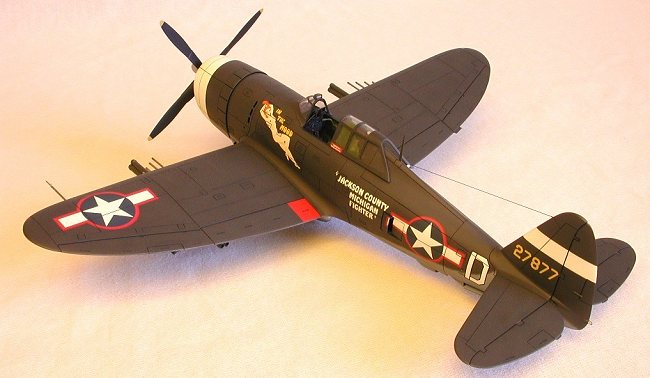
|
REFERENCES |
P-47 Thunderbolt In Action – Larry Davis; Squadron-Signal Publications
Aces Of The Eighth – Gene B. Stafford & William N. Hess; Squadron-Signal Publications
The Mighty Eighth – Roger Freeman; Scribner’s
Classic Aircraft: Fighters – Bill Gunston; Motorbooks International
AAF: The Official WWII Guide To The Army Air Forces – Reprint by Bonanza Books
Fighters Of The Mighty Eighth – William N. Hess & Thomas G. Ivie; Motorbooks International
Fighter Command: American Fighters In Original WWII Color – Jeffrey L. Ethell & Robert T.
Sand; Motorbooks International
Ó October 2001 by Roger M. Jackson
If you would like your product reviewed fairly and quickly by a site that averages thousands of visits a day, please contact me or see other details in the Note to Contributors.